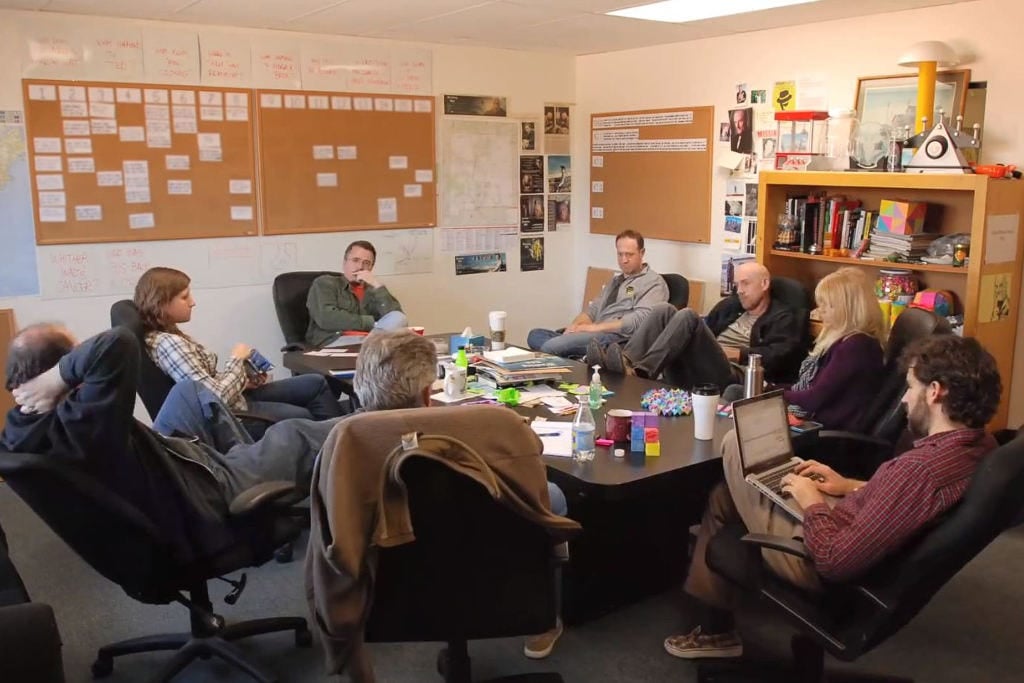Jennifer Kassabian Takes You Inside the Writers' Room for a Day
April 23, 2024
Landing a staff writing gig on a TV show is pretty much every aspiring screenwriter’s dream. However, what exactly goes on in a writers’ room remains a mystery for those starting their careers. How long are the hours? Who writes which episode and why? When do you eat lunch?
Producer and writer Jennifer Kassabian (Degrassi: Next Class, Hudson & Rex) pulls back the curtain on the day-to-day functions of a writers’ room, including what a typical day looks like, breaking a story, and breaking for lunch.
Read More: How You Can Create the Perfect Environment for Screenwriting
Who’s in a Writers’ Room?
According to Kassabian, the size of a room “always depends on budget—a small room is four people, a ‘healthy’ room is five to seven. I’m in a room that has eight people now, and that’s a luxury,” she says.
The room consists of the showrunner/executive producer, their Number 2 (usually a co-executive producer/writer) and then a couple of senior-mid level writers/producers (supervising producer or consulting producer, producer), then junior non-producing writers (executive story editors and story editor) and the story coordinator “who is the most junior in a room, and that role is usually the entry point into writing rooms,” Kassabian explains.
Roles correlate to credit. The more senior you are, the more you will be doing. “So, a showrunner is running the series,” Kassabian says. “Producing writers are not only working in the writers' room but also ‘producing’ their episodes, so they are in prep meetings and on set. Non-producing writers are there to just break the story and write a script. A coordinator is the liaison between the writers' room and the rest of production—they are responsible for releasing the scripts to the departments, and revisions.”

Who’s Running the Room?
Typically, the showrunner is running the writers’ room, or the showrunner’s number two is provided if the showrunner is pulled to a meeting, network calls, or set. But just because they’re the ones running the room doesn’t mean they’re the only ones who are deciding which stories to tell.
“The idea is that you jump in with your idea when you have it—some rooms have a hierarchy—where it’s understood the senior writers should have more of the floor—some rooms don’t like the hierarchy and just want everyone to jump in when they have something of value to add,” Kassabian explains.
At some point, the room finds a rhythm, which Kassabian says can sometimes take a few weeks “where you learn who likes to pitch certain ideas about character, who is better with [the] story, who likes to stay quiet for a bit then come in with a great pitch, who is better at logic threads, etc. And from there, you learn the room’s rhythm and how and when to jump in.” But a good rule is not to talk more than the showrunner.
Read More: Finding Your Voice

What’s a Typical Day Like?
Writers’ rooms are like 9-5 jobs. Rooms operate five days a week and typically run from nine or ten in the morning to five or six at night. In the COVID-19 era, Kassabian says room hours “got a bit shorter because of Zoom fatigue.”
A typical day includes 30-40 minutes of pre-room chat, maybe chatting about what people did last night, shows people are watching, etc. Then, Kassabian says the chat slides to thoughts related to the previous day’s work or ideas anyone had during the night, which includes showrunners, the writer in charge of the specific episode, and just free-for writers in the room who had thoughts.
“Then you slide into breaking the current episode—which is most of the day (save for lunch),” she explains. “Sometimes, a day might include room notes if a script is about to be submitted to execs. If you are a writer on draft, you are not in the room but off writing your episode. So, there is a natural rotation within the system of who’s around and who is off writing—that’s what’s typical.”
When you are in a writing room pre-production, Kassabian shares that most of the day is spent in the room breaking stories, or you’re off on assignment writing your episode. “As soon as production starts, story-breaking is interrupted by prep meetings, production, read-throughs, etc,” she says. “So, writer/producers in the room are pulled out for that, versus none of that happening earlier in the season. The hours don’t change, but the story-room brain power ebbs and flows depending on what’s shooting.”
Breaking for lunch is always a must. “When we are not in production, lunch is a real lunch, people chatting and catching up,” Kassabian shares. “Once you are in production, lunch is usually shorter, with chatter related to what everyone’s doing that day, how the set is going, last-minute rewrites for upcoming scenes, etc.”

Who Decides on Stories?
Stories are decided by the showrunner, who will say they like the idea or, as Kassabian puts it, “you feel the energy in the room when the story is well received. Then, it’s like a democracy—everyone gets on board for it.”
Every story for each episode is broken in the room—exceptions to this are if the room is wrapped before the showrunner fully breaks the finale, “but at least a soft break will happen,” Kassabian says.
The showrunner also decides who writes what episode. Sometimes, they assign the script after the room has broken, which Kassabian says lends itself to the idea that because you don’t know if it will be yours’ to write, “no one phones it in, and everyone breaks because it could be the episode you write.”
On the other hand, she says some rooms just tell you the order you will write in so that you can bring some of the ideas specifically for the episode you will write. For example, if it’s a procedural, that’s usually the crime of the week, so you can prepare on what to pitch. But in the end, the showrunner delegates.
The usual turnaround is a week for each stage of the draft. “So, a week for outline, a week for first draft (some shows give a week and a half), and then a week for second draft,” Kassabian explains. “Subsequent drafts get less time because, ideally, you are just tweaking and addressing notes. How long you have before your episode is shot, just depends on when your script is up in the assembly line. So, if you are early, your script will shoot sooner, etc.”

What Happens in a Writers’ Room That No One Talks About?
“Every show has one episode a season that just does not work,” Kassabian says. “And you end up breaking it more than any other episode—and even then, a few more times. It usually comes in the 6th or 7th episode out of 10 because a lot of ideas have been used. Then, the last few episodes have content being saved for it. In an episode of 18, it shows up around 13 or 14, and it’s just so tedious and arduous to get over that hump!”
Another thing that she found surprising about a writers’ room is “how close a writer’s room can get—you are spending more time with these people than your own family, and then when a show wraps—you may never talk to them again!”
That, and “writers' rooms have the best snacks in all of the production!”
Read More: San Diego Comic-Con: Inside the Writers' Room with Mark A. Altman
Written by: Brianne Hogan
Brianne Hogan is a freelance writer currently based in Prince Edward Island. A film studies graduate from NYU, her byline's been featured in Creative Screenwriting, ScreenCraft, The Huffington Post, among others. "Jurassic Park" is unashamedly her favorite movie (at this moment). You can follow Brianne on Twitter via @briannehogan



